Square Wave Tests
These tests show the PIMETA v2.00’s response to square waves. There are several purposes to this. Below each oscillogram is a brief hint as to what it is you’re looking at, and why it is interesting.
If you have an oscilloscope and a square wave generator, I highly recommend doing tests like these on your amp. It’s a really easy way to get a lot of useful information about the amp. It’s not as easy to interpret the results as with RMAA, but the tests are much easier to conduct correctly. Once you know how to interpret the results quickly, the test becomes interactive, as you can just watch the scope display as you fiddle with the circuit and generator settings. I find that it takes several minutes to do each RMAA test run and then go through the results. That makes thinking about the effect of your changes much harder than when you can just watch what happens in real time.
The orange traces in the oscillograms show the output of the generator itself. The blue traces are the same waveform at the output of the PIMETA v2 amp. I tried to configure the scope display to show as many useful measurements as I could to make several numeric comparisons possible, in addition to the obvious visual comparisons.
Delay at 1 kHz
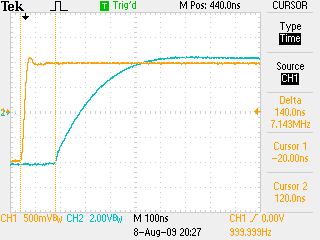
Wave propagation time through the amp. We’re zoomed in deep on the time axis, so the blue trace rise time looks slower than it really is.
100 kHz, 1 V, No Load
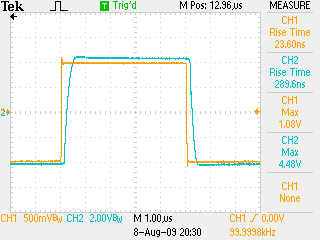
Like delay test, only 100× faster and zoomed out to show steepness of blue curve. At 1 kHz, it’s even steeper. Notice how little peaking there is on the blue trace. This amp’s C6 is well-chosen.
2 MHz, 1 V, No Load
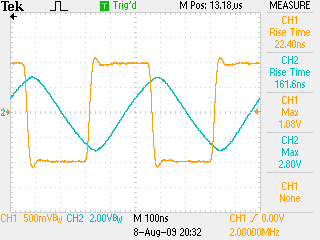
Like above, but as fast as the amp goes. Just under this point, the triangles start broadening back out into proper square waves.
1 MHz, 200 mV, no-load
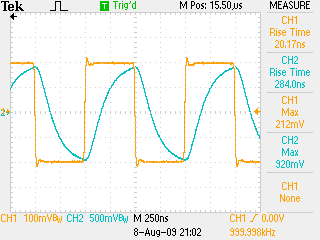
Square wave almost degenerated to a triangle by C6.
1 MHz, 200 mV, 330 Ω
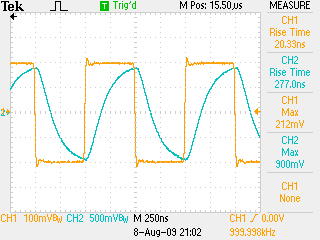
Same as above, but now driving a load equivalent to high-impedance headphones. Very little effect on the response.
1 MHz, 200 mV, 33 Ω
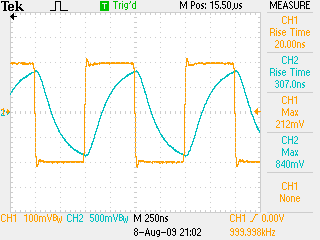
Same as above, but load increased to low-impedance headphone equivalent. Only affects the amplitude a bit; wave shape still holding up.
Test Details
The most important thing you need for a test like this is a solid square wave generator. The very thing that makes square wave tests useful also makes them hard to generate properly: an ideal square wave is literally composed of infinite frequencies. If we get the fundamental and the next 9 or so harmonics down solidly, we have “good enough” square waves for our purposes here.
Think about what that means in practical terms: for that 2 MHz test above, we want a generator with at least a 20 MHz bandwidth. You don’t have to go this fast on your own tests, but do realize, you can’t expect to get even 20 kHz square waves out of a sound card, unless it’s one of the top-end sort with 192 kHz bandwidth. Even then, you’re probably better off getting a dedicated signal generator. Sound cards are better for audio frequency sine waves, but for square and triangle waves, they can’t keep up.
The above also applies to the scope, by the way, but it’s less a concern because most scopes are fast enough for this anyway. Hobbyist-class signal generators, though, are often not as fast as we really want for tests like this.
This space intentionally left blank. :)